Influence of Autochthonous Lactic Acid Bacteria Cultures on the Microbiota and Biogenic Amine Production in Medium-Ripened Artisan Goat Cheese
Abstract
1. Introduction
2. Materials and Methods
2.1. Materials
2.2. Preparation of Strain Inoculum and Processing of Goat Coalho Cheese
2.3. Microbiological Quality of Cheese Samples
2.4. Biogenic Amines Determination
2.5. Metataxonomic Analysis
2.6. Statistical Analysis
3. Results
3.1. Microbiological Analysis
3.2. Biogenic Amines Determination
3.3. Metataxonomic Analysis
4. Discussion
5. Conclusions
Author Contributions
Funding
Institutional Review Board Statement
Informed Consent Statement
Data Availability Statement
Acknowledgments
Conflicts of Interest
References
- dos Santos, K.M.O.; Bomfim, M.A.D.; Vieira, A.D.S.; Benevides, S.D.; Saad, S.M.I.; Buriti, F.C.A.; Egito, A.S. Probiotic caprine Coalho cheese naturally enriched in conjugated linoleic acid as a vehicle for Lactobacillus acidophilus and beneficial fatty acids. Intern. Dairy J. 2012, 24, 107–112. [Google Scholar] [CrossRef]
- de Moraes, G.M.D.; dos Santos, K.M.O.; de Barcelos, S.C.; Lopes, S.A.; do Egito, A.S. Potentially probiotic goat cheese produced with autochthonous adjunct culture of Lactobacillus mucosae: Microbiological, physicochemical and sensory attributes. LWT Food Sci. Technol. 2018, 94, 57–63. [Google Scholar] [CrossRef]
- Silva, R.A.; Bezerra, V.S.; Pimentel, M.d.C.B.; Porto, A.L.F.; Cavalcanti, M.T.H.; Filho, J.L.L. Proteomic and Peptidomic Profiling of Brazilian Artisanal “Coalho” Cheese. J. Sci. Food Agric. 2016, 96, 4337–4344. [Google Scholar] [CrossRef] [PubMed]
- Bezerra, T.K.A.; Arcanjo, N.; Araújo, A.; Lima, M.; de Queiroz, A.; Oliveira, M.; Gomes, A.; Madruga, M. Volatile profile in goat coalho cheese supplemented with probiotic lactic acid bacteria. LWT Food Sci. Technol. 2017, 76, 209–215. [Google Scholar] [CrossRef]
- Cavalcanti, M.T.; Xavier, L.E.; Feitosa, B.F.; Alencar-Luciano, W.; Feitosa, V.A.; de Souza, E.L.; Gonçalves, M.C. Influence of red wine marination on the quality, safety, and stability of goat Coalho cheese produced in the Brazilian semi-arid region. Food Biosci. 2023, 53, 102727. [Google Scholar] [CrossRef]
- Aragão, B.B.; Trajano, S.C.; Silva, J.G.; Oliveira, R.P.; Pinheiro Junior, J.W.; Peixoto, R.M.; Mota, R.A. High frequency of β-lactam-resistant Staphylococcus aureus in artisanal Coalho cheese made from goat milk produced in northeastern Brazil. J. Dairy Sci. 2019, 102, 6923–6927. [Google Scholar] [CrossRef]
- Montel, M.-C.; Buchin, S.; Mallet, A.; Delbes-Paus, C.; Vuitton, D.A.; Desmasures, N.; Berthier, F. Traditional cheeses: Rich and diverse microbiota with associated benefits. Int. J. Food Microbiol. 2014, 177, 136–154. [Google Scholar] [CrossRef]
- Nelli, A.; Venardou, B.; Skoufos, I.; Voidarou, C.; Lagkouvardos, I.; Tzora, A. An Insight into Goat Cheese: The Tales of Artisanal and Industrial Gidotyri Microbiota. Microorganisms 2023, 11, 123. [Google Scholar] [CrossRef]
- Penland, M.; Falentin, H.; Parayre, S.; Pawtowski, A.; Maillard, M.-B.; Thierry, A.; Mounier, J.; Coton, M.; Deutsch, S.-M. Linking Pélardon artisanal goat cheese microbial communities to aroma compounds during cheese-making and ripening. Int. J. Food Microbiol. 2021, 345, 109130. [Google Scholar] [CrossRef]
- Silvetti, T.; Capra, E.; Morandi, S.; Cremonesi, P.; Decimo, M.; Gavazzi, F.; Giannico, R.; De Noni, I.; Brasca, M. Microbial population profile during ripening of Protected Designation of Origin (PDO) Silter cheese, produced with and without autochthonous starter culture. LWT Food Sci. Technol. 2017, 84, 821–831. [Google Scholar] [CrossRef]
- Tsanasidou, C.; Bosnea, L.; Kakouri, A.; Samelis, J. Biogenic Amine Formation in Artisan Galotyri PDO Acid-Curd Cheeses Fermented with Greek Indigenous Starter and Adjunct Lactic Acid Bacteria Strain Combinations: Effects of Cold (4 °C) Ripening and Biotic Factors Compromising Cheese Safety. Appl. Microbiol. 2024, 4, 536–562. [Google Scholar] [CrossRef]
- Adámek, R.; Pachlová, V.; Salek, R.N.; Němečková, I.; Buňka, F.; Buňková, L. Reduction of biogenic amine content in Dutch-type cheese as affected by the applied adjunct culture. LWT Food Sci. Technol. 2021, 152, 112397. [Google Scholar] [CrossRef]
- Pessione, E.; Cirrincione, S. Bioactive Molecules Released in Food by Lactic Acid Bacteria: Encrypted Peptides and Biogenic Amines. Front. Microbiol. 2016, 7, 876. [Google Scholar] [CrossRef] [PubMed]
- Marco, M.L.; Hill, C.; Hutkins, R.; Slavin, J.; Tancredi, D.J.; Merenstein, D.; Sanders, M.E. Should There Be a Recommended Daily Intake of Microbes? J. Nutr. 2020, 150, 3061–3067. [Google Scholar] [CrossRef]
- Zoumpopoulou, G.; Papadimitriou, K.; Alexandraki, V.; Mavrogonatou, E.; Alexopoulou, K.; Anastasiou, R.; Gerogalaki, M.; Kletsas, D.; Tsakalidou, E.; Giaouris, E. The microbiota of Kalathaki and Melichloro Greek artisanal cheeses comprises functional lactic acid bacteria. LWT Food Sci. Technol. 2020, 130, 109570. [Google Scholar] [CrossRef]
- de Moraes, G.M.D.; de Abreu, L.R.; do Egito, A.S.; Salles, H.O.; da Silva, L.M.F.; Nero, L.A.; Todorov, S.D.; Dos Santos, K.M.O. Functional properties of Lactobacillus mucosae strains isolated from Brazilian goat milk. Probiotics Antimicrob. Proteins 2017, 9, 235–245. [Google Scholar] [CrossRef] [PubMed]
- Bomfim, V.B.; Neto, J.H.P.L.; Leite, K.S.; de Andrade Vieira, É.; Iacomini, M.; Silva, C.M.; dos Santos, K.M.O.; Cardarelli, H.R. Partial characterization and antioxidant activity of exopolysaccharides produced by Lactobacillus plantarum CNPC003. LWT Food Sci. Technol. 2020, 127, 109349. [Google Scholar] [CrossRef]
- De Barcelos, S.C.; do Egito, A.S.; dos Santos, K.M.O.; de Moraes, G.M.D.; Teixeira Sá, D.M.A. Effect of Acerola (Malpighia emarginata DC) Pulp Incorporation on Potentially Probiotic Petit-Suisse Goat Cheese. J. Food Process Preserv. 2020, 44, e14511. [Google Scholar] [CrossRef]
- Galdino, I.K.C.P.O.; Oliveira, M.M.; Oliveira, A.T.; da Silva, G.M.; de Oliveira, T.A.; dos Santos, K.M.O.; Egito, A.S.D.; Buriti, F.C.A. Fermentative behavior of native lactobacilli in goat milk and their survival under in vitro simulated gastrointestinal conditions. LWT Food Sci. Technol. 2021, 135, 109905. [Google Scholar] [CrossRef]
- de Oliveira, C.M.S.; Grisi, C.V.B.; Silva, G.d.S.; Lopes Neto, J.H.P.; de Medeiros, L.L.; dos Santos, K.M.O.; Cardarelli, H.R. Use of Lactiplantibacillus plantarum CNPC 003 for the manufacture of functional skimmed fresh cheese. Int. Dairy J. 2023, 141, 105628. [Google Scholar] [CrossRef]
- Costa, C.N.M.; de Oliveira, J.M.C.; da Silva Alves, A.M.; de Lima, K.Y.G.; Campos, M.I.F.; do Egito, A.S.; dos Santos, K.M.O.; Gonçalves, M.C.; de Souza, E.L.; Pacheco, M.T.B.; et al. Effect of Lactiplantibacillus plantarum CNPC003 and milk pasteurization on artisanal goat coalho cheese characteristics. Int. Dairy J. 2024, 155, 105972. [Google Scholar] [CrossRef]
- Zotta, T.; Ricciardi, A.; Condelli, N.; Parente, E. Metataxonomic and Metagenomic Approaches for the Study of Undefined Strain Starters for Cheese Manufacture. Crit. Rev. Food Sci. Nutr. 2022, 62, 3898–3912. [Google Scholar] [CrossRef] [PubMed]
- de Abreu, L.R. Identification and Characterization of Probiotic Potential of Bacteria Isolated from Milk and Goat Cheese. Master’s Thesis, Federal University of Ceará, Sobral, Brazil, 2015. (In Portuguese). [Google Scholar]
- de Oliveira, M.E.G.; Garcia, E.F.; Queiroga, R.D.C.R.E.; de Souza, E.L. Technological, Physicochemical and Sensory Characteristics of a Brazilian Semi-Hard Goat Cheese (Coalho) with Added Probiotic Lactic Acid Bacteria. Sci. Agric. 2012, 69, 370–379. [Google Scholar] [CrossRef]
- APHA. Compendium of Methods for the Microbiological Examination of Foods; APHA: Washington, DC, USA, 2015; ISSN 1541-0048. [Google Scholar]
- dos Santos, K.M.O.; Vieira, A.D.S.; Buriti, F.C.A.; do Nascimento, J.C.F.; de Melo, M.E.S.; Bruno, L.M.; de Fátima Borges, M.; Rocha, C.R.C.; de Souza Lopes, A.C.; de Melo Franco, B.D.G.; et al. Artisanal Coalho cheeses as source of beneficial Lactobacillus plantarum and Lactobacillus rhamnosus strains. Dairy Sci. Technol. 2015, 95, 209–230. [Google Scholar] [CrossRef]
- Restuccia, D.; Spizzirri, U.G.; Puoci, F.; Cirillo, G.; Curcio, M.; Parisi, O.I.; Iemma, F.; Picci, N. A New Method for the Determination of Biogenic Amines in Cheese by LC with Evaporative Light Scattering Detector. Talanta 2011, 85, 363–369. [Google Scholar] [CrossRef] [PubMed]
- Mantoanelli, J.O.F.; Gonçalves, L.M.; Pereira, E.A. Dansyl Chloride as a Derivatizing Agent for the Analysis of Biogenic Amines by CZE-UV. Chromatographia 2020, 83, 767–778. [Google Scholar] [CrossRef]
- Melo, A.S. O What Do We Gain by “Confounding” Species Richness and Evenness in a Diversity Index? Biota Neotrop. 2008, 8, 22–26. (In Portuguese) [Google Scholar] [CrossRef]
- Silva, F.R.; Gonçalves-Souza, T.; Paterno, G.B.; Provete, D.B.; Vancine, M.H. Ecological Data Analysis in R, 1st ed.; Nupeea: Recife, Brazil, 2022; 640p. (In Portuguese) [Google Scholar] [CrossRef]
- Brazil. Ministry of Agriculture, Cattle and Supplying. Ordinance No. 146, of March 7, 1996. Approves the Technical Regulations for the Identity and Quality of Dairy Products. Diário Oficial da União, 11 March 1996; p. 3979. (In Portuguese) [Google Scholar]
- Dolci, P.; Ferrocino, I.; Giordano, M.; Pramotton, R.; Vernetti-Prot, L.; Zenato, S.; Barmaz, A. Impact of Lactococcus lactis as starter culture on microbiota and metabolome profile of an Italian raw milk cheese. Int. Dairy J. 2020, 110, 104804. [Google Scholar] [CrossRef]
- van Hoorde, K.; van Leuven, I.; Dirinck, P.; Heyndrickx, M.; Coudijzer, K.; Vandamme, P.; Huys, G. Selection, application and monitoring of Lactobacillus paracasei strains as adjunct cultures in the production of Gouda-type cheeses. Int. J. Food Microbiol. 2010, 144, 226–235. [Google Scholar] [CrossRef]
- Iyer, A.; Mukherjee, A.; Gómez-Sala, B.; O’Connor, E.M.; Kenny, J.G.; Cotter, P.D. The impact of live dietary microbes on health: A scoping review. J. Food Sci. 2024, 89, 773–792. [Google Scholar] [CrossRef]
- Marco, M.L.; Hutkins, R.; Hill, C.; Fulgoni, V.L.; Cifelli, C.J.; Gahche, J.; Slavin, J.L.; Merenstein, D.; Tancredi, D.J.; Sanders, M.E. A Classification System for Defining and Estimating Dietary Intake of Live Microbes in US Adults and Children. J. Nutr. 2022, 152, 1729–1736. [Google Scholar] [CrossRef] [PubMed]
- Binda, S.; Hill, C.; Johansen, E.; Obis, D.; Pot, B.; Sanders, M.E.; Tremblay, A.; Ouwehand, A.C. Criteria to Qualify Microorganisms as “Probiotic” in Foods and Dietary Supplements. Front. Microbiol. 2020, 11, 1662. [Google Scholar] [CrossRef]
- Cichosz, G.; Aljewicz, M.; Nalepa, B. Viability of the Lactobacillus rhamnosus HN001 probiotic strain in Swiss- and Dutch-type cheese and cheese-like products. J. Food Sci. 2014, 79, 1181–1188. [Google Scholar] [CrossRef] [PubMed]
- Karimi, R.; Mortazavian, A.M.; Da Cruz, A.G. Viability of probiotic microorganisms in cheese during production and storage: A review. Dairy Sci. Technol. 2011, 91, 283–308. [Google Scholar] [CrossRef]
- Lovayová, V.; Dudriková, E.; Rimárová, K.; Siegfried, L. Quantity of selected probiotic cultures in semi-hard cheese with low-cooking curd during the maturation process. J. Food Sci. Technol. 2015, 52, 4697–4702. [Google Scholar] [CrossRef][Green Version]
- Terpou, A.; Papadaki, A.; Lappa, I.K.; Kachrimanidou, V.; Bosnea, L.A.; Kopsahelis, N. Probiotics in food systems: Significance and emerging strategies towards improved viability and delivery of enhanced beneficial value. Nutrients 2019, 11, 1591. [Google Scholar] [CrossRef]
- Martins, A.A.; Santos-Junior, V.A.; Filho, E.R.; Silva, H.L.; Ferreira, M.V.S.; Graça, J.S.; Esmerino, E.A.; Lollo, P.C.; Freitas, M.Q.; Sant’Ana, A.S.; et al. Probiotic Prato cheese consumption attenuates development of renal calculi in animal model of urolithiasis. J. Funct. Foods 2018, 49, 378–383. [Google Scholar] [CrossRef]
- Rodrigues, R.; Guerra, G.; Soares, J.; Santos, K.; Rolim, F.; Assis, P.; Araújo, D.; de Araújo Júnior, R.F.; Garcia, V.B.; de Araújo, A.A. Lactobacillus rhamnosus EM1107 in goat milk matrix modulates intestinal inflammation involving NF-κB p65 and SOCs-1 in an acid-induced colitis model. J. Funct. Foods 2018, 50, 78–92. [Google Scholar] [CrossRef]
- Sperry, M.F.; Silva, H.L.A.; Balthazar, C.F.; Esmerino, E.A.; Verruck, S.; Prudencio, E.S.; Neto, R.P.C.; Tavares, M.I.B.; Peixoto, J.C.; Nazzaro, F.; et al. Probiotic Minas Frescal cheese added with L. casei 01: Physicochemical and bioactivity characterization and effects on hematological/biochemical parameters of hypertensive overweighted women—A randomized double-blind pilot trial. J. Funct. Foods 2018, 45, 435–443. [Google Scholar] [CrossRef]
- Natrella, G.; Gambacorta, G.; Squeo, G.; Faccia, M. Impact of Milk Thermization on the Quality Characteristics of P.D.O. “Canestrato Pugliese” Ovine Hard Cheese. Foods 2023, 12, 1080. [Google Scholar] [CrossRef]
- Galdino, I.K.C.P.d.O.; da Silva, M.O.M.; da Silva, A.P.A.; Santos, V.N.; Feitosa, R.L.P.; Ferreira, L.C.N.; Dantas, G.C.; Pereira, E.V.d.S.; de Oliveira, T.A.; dos Santos, K.M.O.; et al. β-Glucosidase activity and antimicrobial properties of potentially probiotic autochthonous lactic cultures. PeerJ 2023, 11, e16094. [Google Scholar] [CrossRef] [PubMed]
- Ağagündüz, D.; Şahin, T.Ö.; Ayten, Ş.; Yılmaz, B.; Güneşliol, B.E.; Russo, P.; Spano, G.; Özogul, F. Lactic acid bacteria as pro-technological, bioprotective and health-promoting cultures in the dairy food industry. Food Biosci. 2022, 47, 101617. [Google Scholar] [CrossRef]
- Suárez, N.; Weckx, S.; Minahk, C.; Hebert, E.M.; Saavedra, L. Metagenomics-Based Approach for Studying and Selecting Bioprotective Strains from the Bacterial Community of Artisanal Cheeses. Int. J. Food Microbiol. 2020, 335, 108894. [Google Scholar] [CrossRef]
- Tilocca, B.; Soggiu, A.; Iavarone, F.; Greco, V.; Putignani, L.; Ristori, M.V.; Macari, G.; Spina, A.A.; Morittu, V.M.; Ceniti, C.; et al. The Functional Characteristics of Goat Cheese Microbiota from a One-Health Perspective. Int. J. Mol. Sci. 2022, 23, 14131. [Google Scholar] [CrossRef]
- Barbieri, F.; Montanari, C.; Gardini, F.; Tabanelli, G. Biogenic Amine Production by Lactic Acid Bacteria: A Review. Foods 2019, 8, 17. [Google Scholar] [CrossRef]
- Graham, A.E.; Ledesma-Amaro, R. The microbial food revolution. Nat. Commun. 2023, 14, 2231. [Google Scholar] [CrossRef]
- Tofalo, R.; Schirone, M.; Fasoli, G.; Perpetuini, G.; Patrignani, F.; Manetta, A.C.; Lanciotti, R.; Corsetti, A.; Martino, G.; Suzzi, G. Influence of pig rennet on proteolysis, organic acids content and microbiota of Pecorino di Farindola, a traditional Italian ewe’s raw milk cheese. Food Chem. 2015, 175, 121–127. [Google Scholar] [CrossRef] [PubMed]
- Gardini, F.; Rossi, F.; Rizzotti, L.; Torriani, S.; Grazia, L.; Chiavari, C.; Coloretti, F.; Tabanelli, G. Role of Streptococcus thermophilus PRI60 in histamine accumulation in cheese. Int. Dairy J. 2012, 27, 71–76. [Google Scholar] [CrossRef]
- Rossi, F.; Gardini, F.; Rizzotti, L.; La Gioia, F.; Tabanelli, G.; Torriani, S. Quantitative analysis of histidine decarboxylase gene (hdcA) transcription and histamine production by Streptococcus thermophilus PRI60 under conditions relevant to cheese making. Appl. Environ. Microbiol. 2011, 77, 2817–2822. [Google Scholar] [CrossRef]
- European Commission. Commission Regulation (EC) No. 2073/2005 of 15 November 2005 on microbiological criteria for foodstuffs. Off. J. Eur. Union 2005, 50, 1–26. [Google Scholar]
- EFSA. Scientific opinion on risk based control of biogenic amine formation in fermented foods. EFSA J. 2011, 9, 2393–2486. [Google Scholar] [CrossRef]
- Moreira, G.M.M.; Costa, R.G.B.; Teodoro, V.A.M.; Paula, J.C.J.; Sobral, D.; Fernandes, C.; Gloria, M.B.A. Effect of Ripening Time on Proteolysis, Free Amino Acids, Bioactive Amines and Texture Profile of Gorgonzola-Type Cheese. LWT Food Sci. Technol. 2018, 98, 583–590. [Google Scholar] [CrossRef]

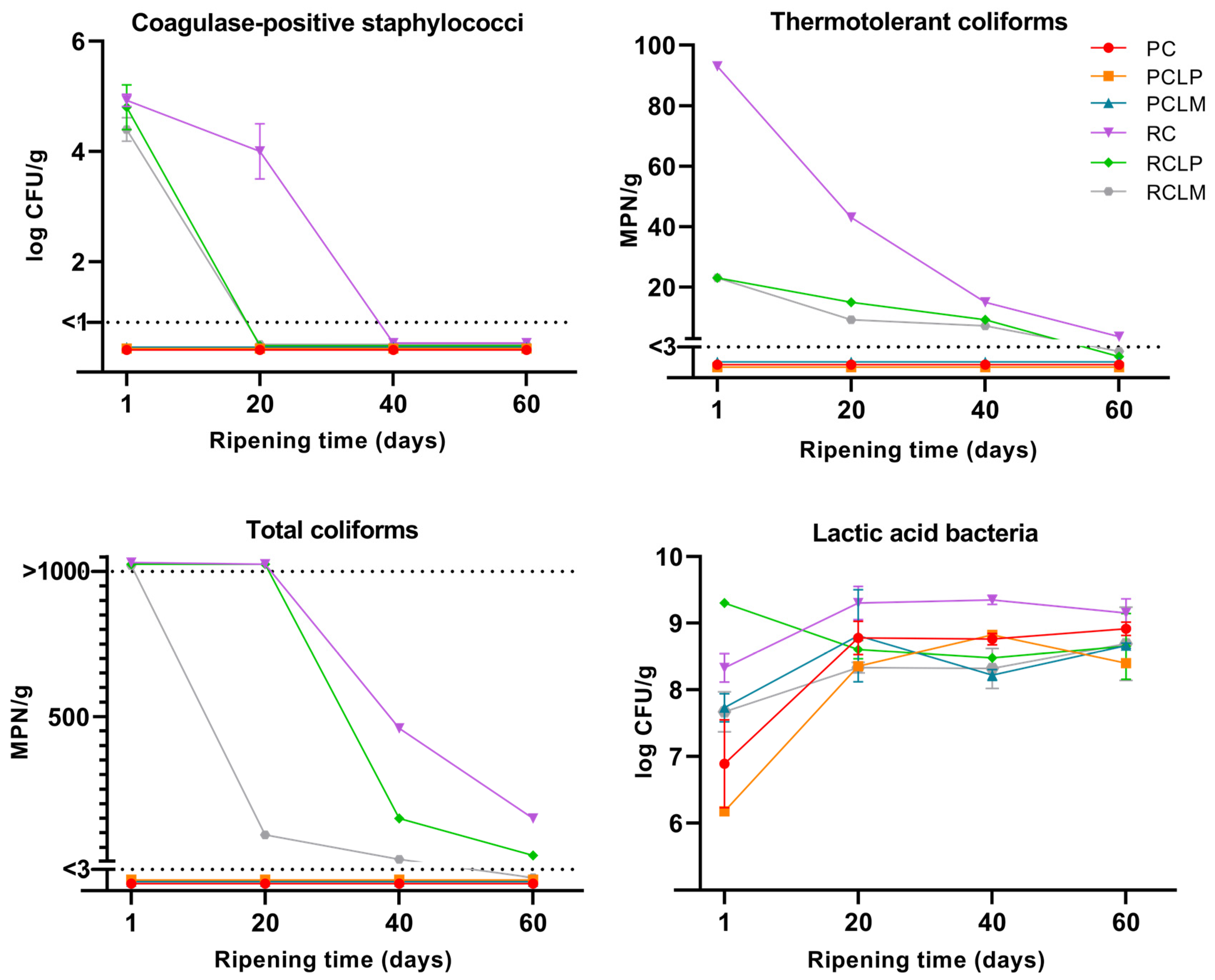
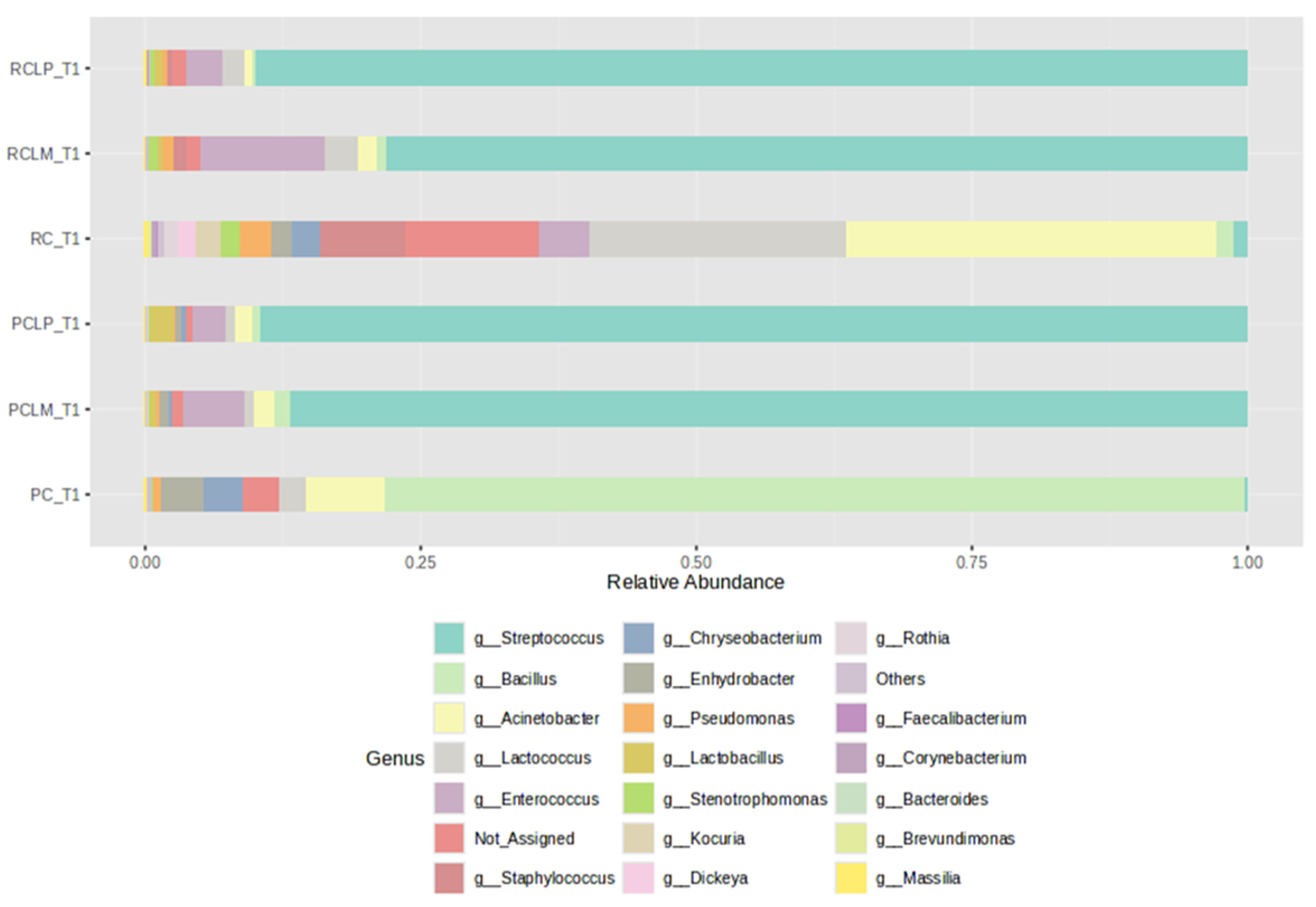

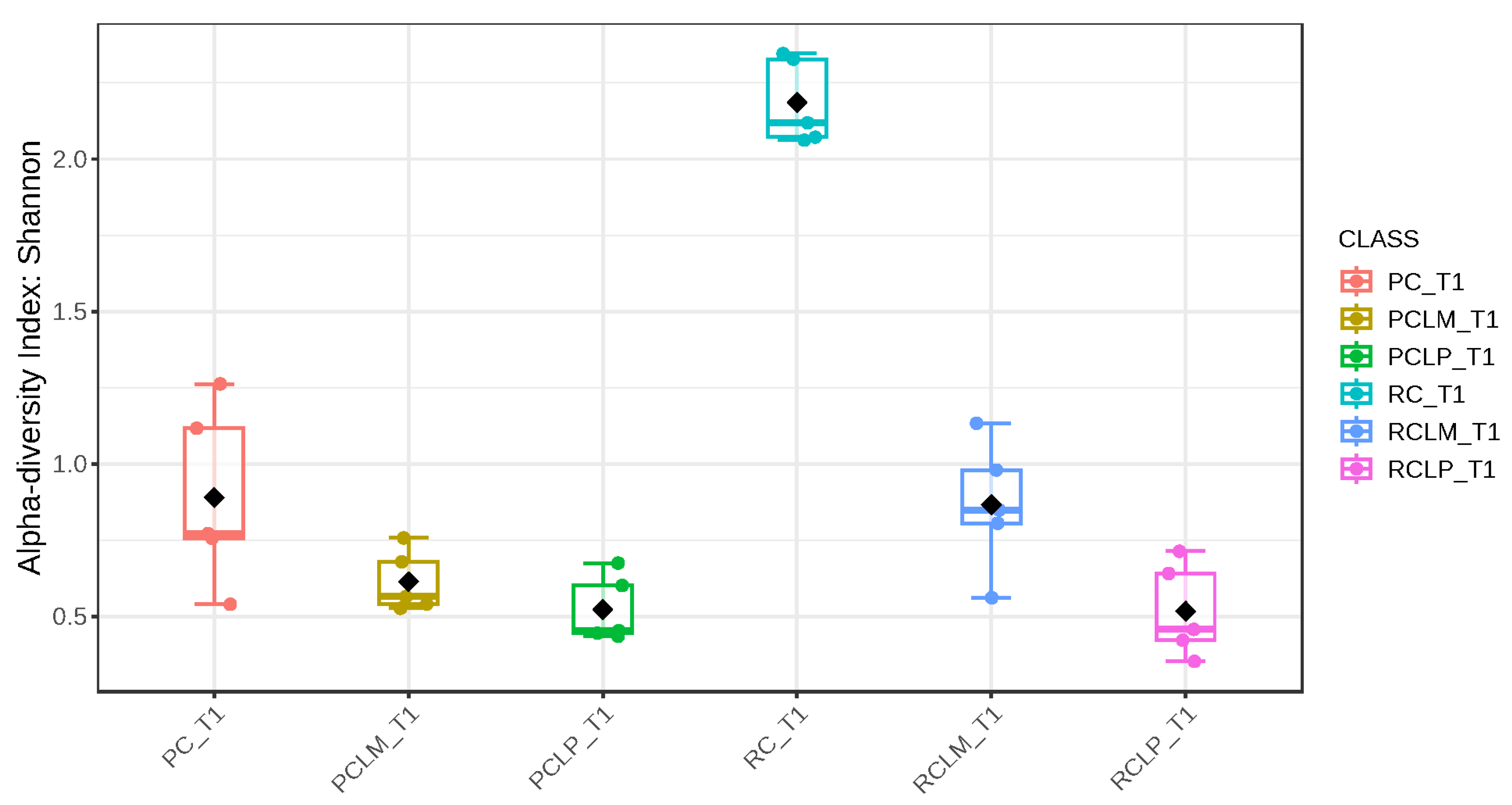
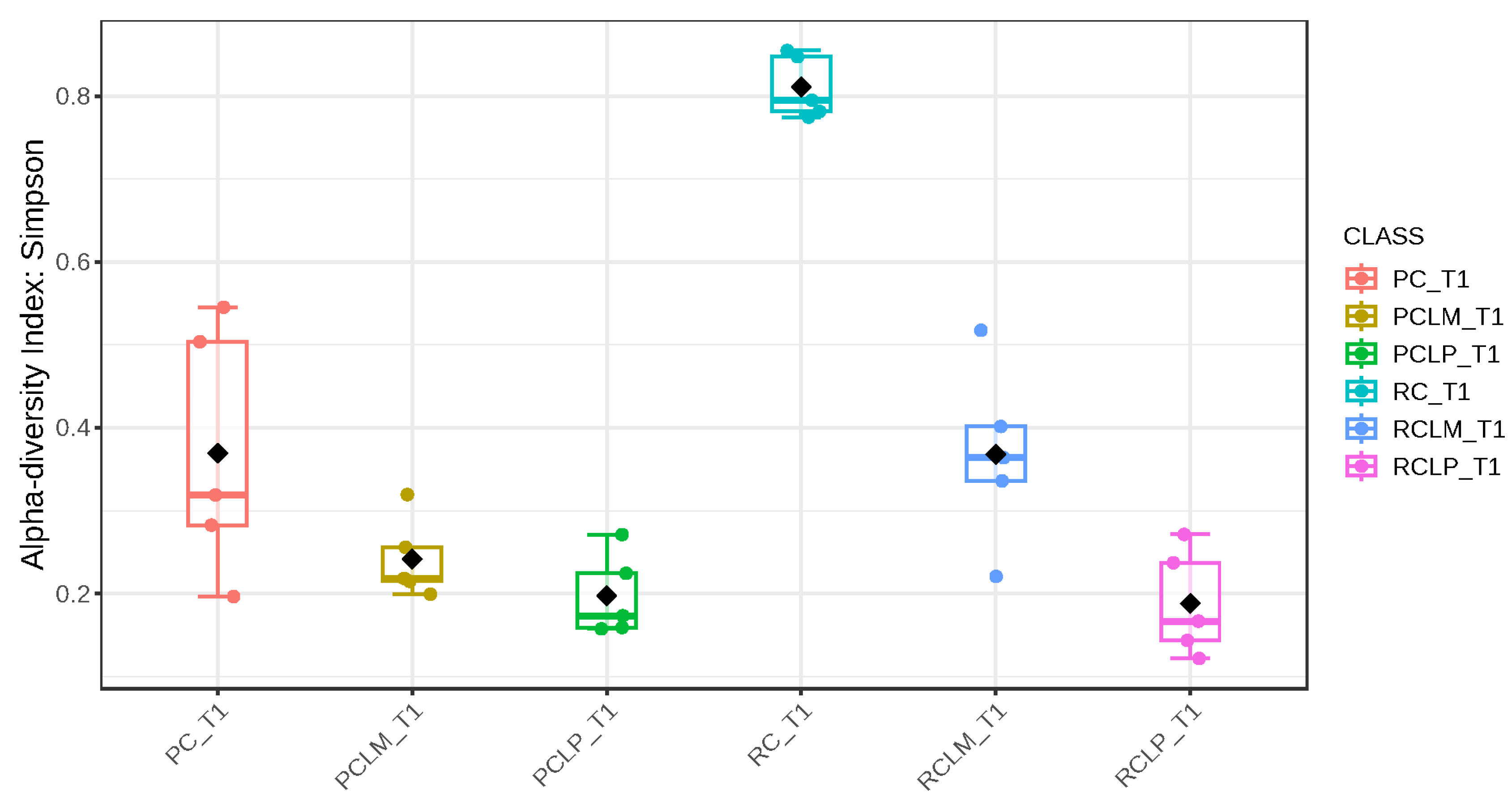

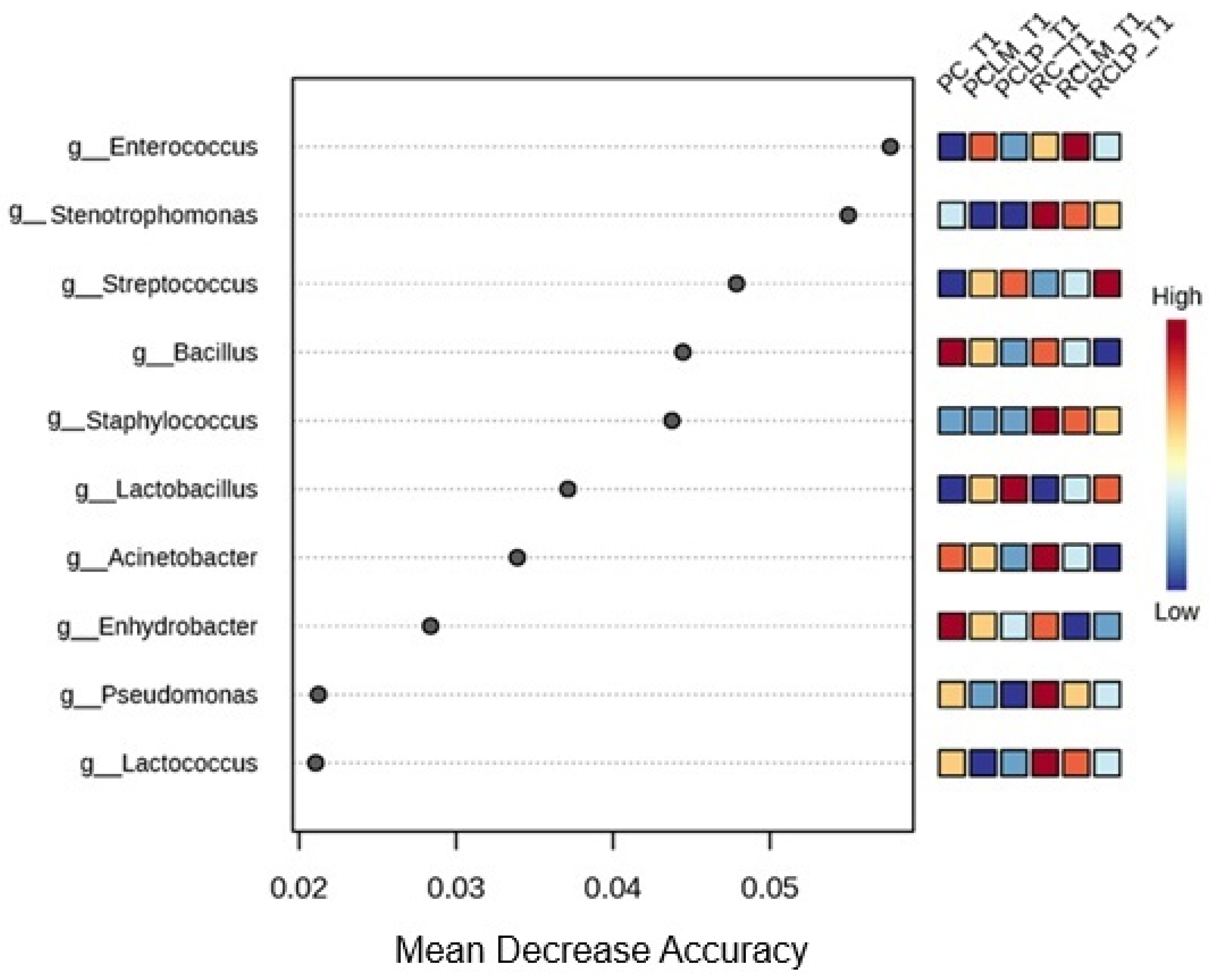
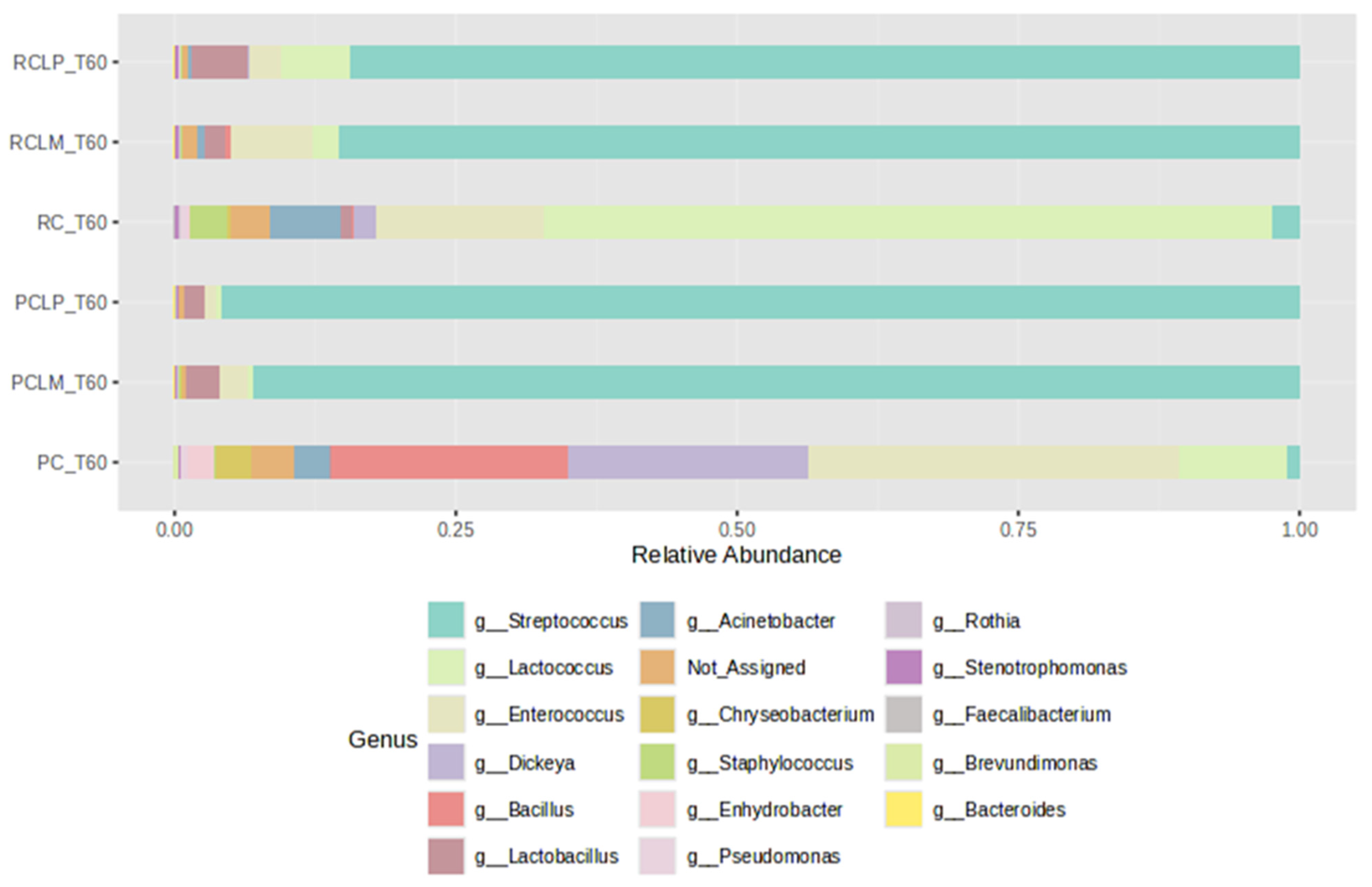
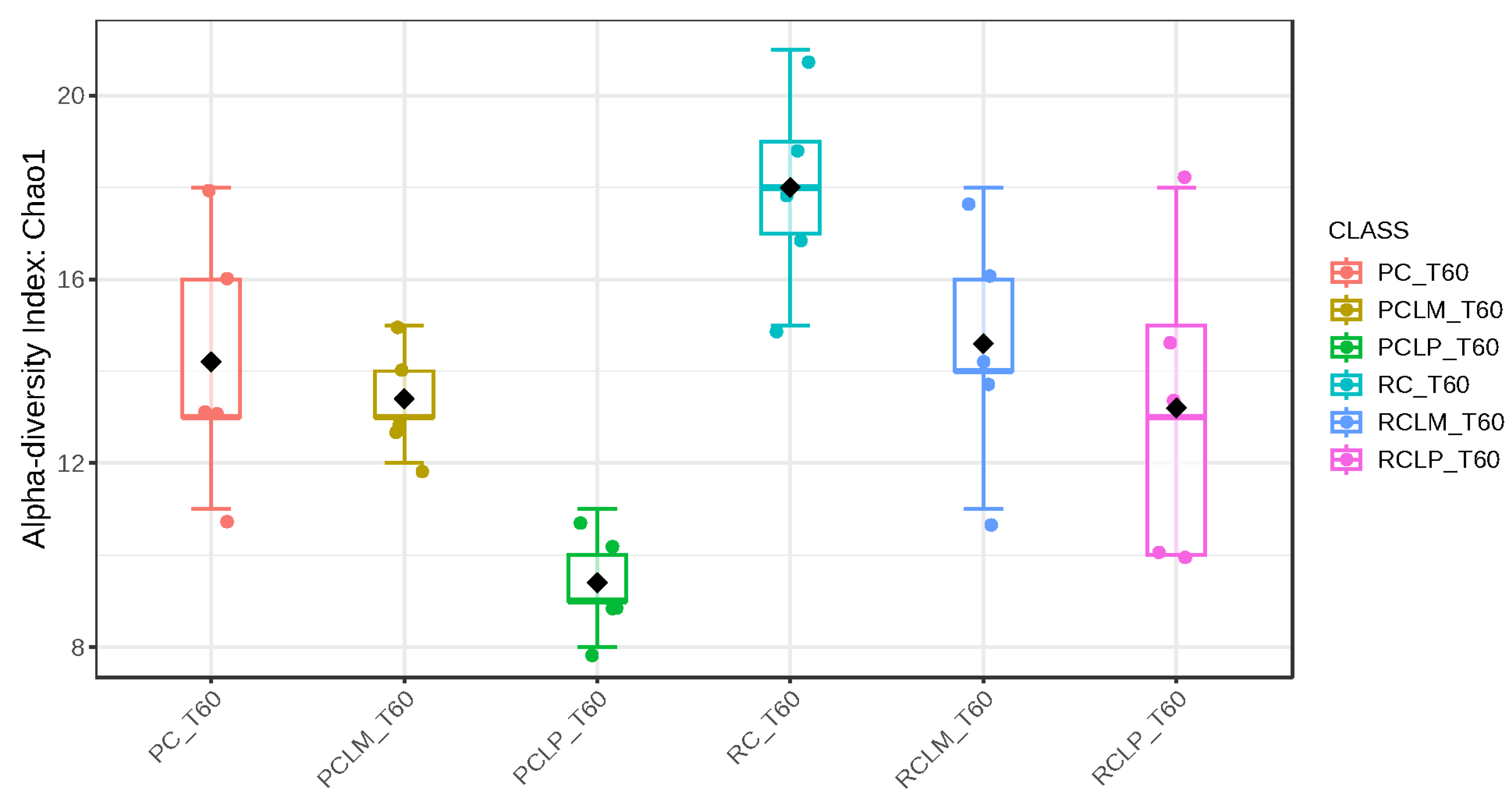

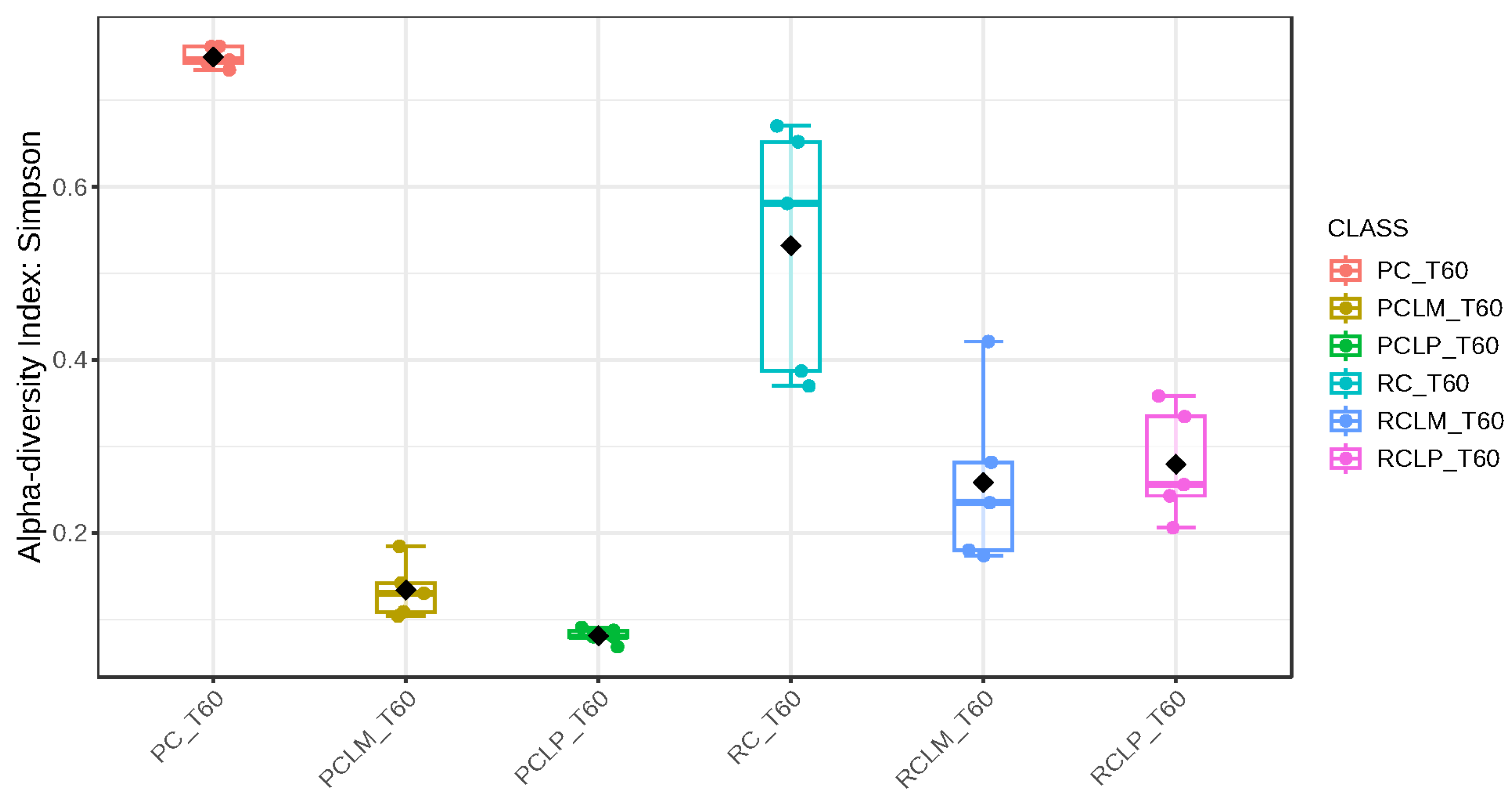

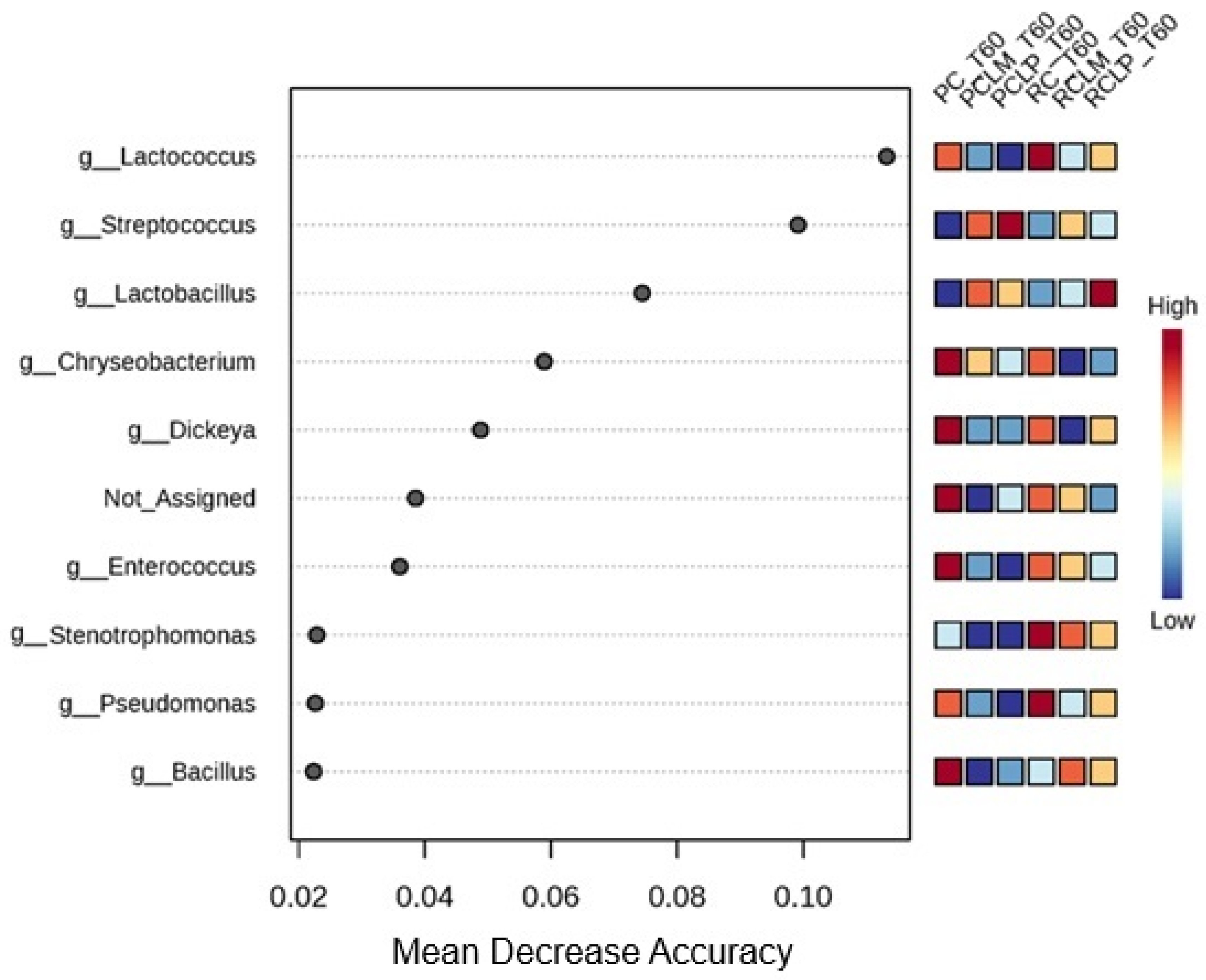
| Biogenic Amine (mg/kg) | Ripening Time (Days) | RC | RCLP | RCLM | PC | PCLP | PCLM |
|---|---|---|---|---|---|---|---|
| Histamine | 1 | 0.09 ± 0.01 dC | 0.16 ± 0.01 cB | 0.20 ± 0.01 cA | <DL bD | <DL cD | <DL dD |
| 20 | 7.18 ± 0.80 bD | 20.16 ± 0.44 aA | 2.54 ± 0.15 bE | 1.67 ± 0.06 aE | 9.75 ± 0.79 aC | 12.79 ± 0.62 aB | |
| 40 | 8.85 ± 0.12 aD | 17.49 ± 0.53 bB | 22.47 ± 0.04 aA | 1.21 ± 0.30 aE | 10.36 ± 1.11 aC | 9.76 ± 1.14 bD | |
| 60 | 2.14 ± 0.04 cD | 17.25 ± 0.63 bB | 23.85 ± 0.74 aA | 1.48 ± 0.01 aD | 6.50 ± 0.04 bC | 5.26 ± 0.21 cC | |
| Spermidine | 1 | <DL d | <DL b | <DL | <DL | <DL | <DL b |
| 20 | 183.78 ±15.58 aA | 0.59 ± 0.05 aC | <DL D | <DL D | <DL D | <DL bD | |
| 40 | 44.22 ±2.35 bA | <DL bC | <DL C | <DL C | <DL C | 0.27 ± 0.08 aB | |
| 60 | 3.43 ± 0.05 cA | <DL bB | <DL B | <DL B | <DL B | <DL bB | |
| Spermine | 1 | <DL | <DLc | <DLc | <DLc | <DL b | <DL c |
| 20 | <DL C | 5.48 ± 0.30 bB | 6.08 ± 2.49 aB | 19.99 ± 1.55 aA | 7.03 ± 2.21 aB | 2.64 ± 0.02 bB | |
| 40 | <DL D | 6.86 ± 0.06 aB | <DL cD | 3.90 ± 0.67 bC | 9.24 ± 0.55 aA | 4.10 ± 0.38 aC | |
| 60 | <DL C | <DL cC | 0.57 ± 0.02 bB | 5.18 ± 1.58 bA | <DL bC | 4.90 ± 0.30 aA | |
| Putrescine | 1 | <DL | <DL b | <DL | <DL c | <DL b | <DL d |
| 20 | <DL C | 0.11 ± 0.01 aA | <DL C | 0.04 ± 0.01 bB | 0.07 ± 0.03 aAB | 0.07 ± 0.01 bAB | |
| 40 | <DL B | <DL bB | <DL B | 0.03 ± 0.01 bA | 0.04 ± 0.01 aA | 0.03 ± 0.01 cA | |
| 60 | <DL C | <DL bC | <DL C | 0.11 ± 0.02 aB | <DL bC | 0.16 ± 0.01 aA | |
| Phenylethylamine | 1 | <DL | <DL | <DL | <DL | <DL | <DL |
| 20 | <DL | <DL | <DL | <DL | <DL | <DL | |
| 40 | <DL | <DL | <DL | <DL | <DL | <DL | |
| 60 | <DL | <DL | <DL | <DL | <DL | <DL | |
| Cadaverine | 1 | <DL b | <DL d | <DL d | <DL c | <DL d | <DL d |
| 20 | 0.11 ± 0.01 aC | 2.77 ± 0.19 bA | 0.77 ± 0.03 aB | 0.79 ± 0.08 bB | 2.22 ± 0.29 bA | 2.14 ± 0.24 cA | |
| 40 | <DL bD | 13.21 ± 0.13 aA | 0.54 ± 0.01 bC | 1.64 ± 1.03 bC | 15.24 ± 0.64 aA | 7.90 ± 2.40 bB | |
| 60 | <DL bD | 0.15 ± 0.01 cC | 0.17 ± 0.01 cC | 4.26 ± 0.01 aB | 0.06 ± 0.01 cC | 21.49 ± 0.88 aA | |
| Tyramine | 1 | <DL d | <DL d | <DL c | <DL b | <DL b | <DL b |
| 20 | 0.12 ± 0.03 cCD | 0.31 ± 0.01 cB | <DL cE | 0.04 ± 0.03 aD | 0.19 ± 0.04 aC | 0.43 ± 0.02 aA | |
| 40 | 0.28 ± 0.02 bC | 0.47 ± 0.01 bB | 0.67 ± 0.04 bA | <DL bD | 0.26 ± 0.04 aC | 0.44 ± 0.07 aB | |
| 60 | 1.00 ± 0.06 aA | 0.71 ± 0.01 aB | 1.01 ± 0.01 aA | 0.09 ± 0.01 aE | 0.40 ± 0.07 aD | 0.51 ± 0.02 aC | |
| ∑ Biogenic amines | 1 | 0.09 | 0.16 | 0.20 | <DL | <DL | <DL |
| 20 | 191.19 | 29.42 | 69.55 | 22.53 | 19.26 | 18.07 | |
| 40 | 53.35 | 38.03 | 23.68 | 6.78 | 35.14 | 22.50 | |
| 60 | 6.57 | 18.11 | 24.60 | 11.12 | 6.96 | 32.32 |
Disclaimer/Publisher’s Note: The statements, opinions and data contained in all publications are solely those of the individual author(s) and contributor(s) and not of MDPI and/or the editor(s). MDPI and/or the editor(s) disclaim responsibility for any injury to people or property resulting from any ideas, methods, instructions or products referred to in the content. |
© 2025 by the authors. Licensee MDPI, Basel, Switzerland. This article is an open access article distributed under the terms and conditions of the Creative Commons Attribution (CC BY) license (https://creativecommons.org/licenses/by/4.0/).
Share and Cite
de Oliveira, J.M.C.; Antunes, A.E.C.; Sales, G.F.C.; Costa, C.N.M.; Alves, A.M.d.S.; de Lima, K.Y.G.; de Oliveira, C.J.B.; do Egito, A.S.; dos Santos, K.M.O.; de Souza, E.L.; et al. Influence of Autochthonous Lactic Acid Bacteria Cultures on the Microbiota and Biogenic Amine Production in Medium-Ripened Artisan Goat Cheese. Foods 2025, 14, 1561. https://doi.org/10.3390/foods14091561
de Oliveira JMC, Antunes AEC, Sales GFC, Costa CNM, Alves AMdS, de Lima KYG, de Oliveira CJB, do Egito AS, dos Santos KMO, de Souza EL, et al. Influence of Autochthonous Lactic Acid Bacteria Cultures on the Microbiota and Biogenic Amine Production in Medium-Ripened Artisan Goat Cheese. Foods. 2025; 14(9):1561. https://doi.org/10.3390/foods14091561
Chicago/Turabian Stylede Oliveira, Julia Mariano Caju, Adriane Elisabete Costa Antunes, Gustavo Felipe Correia Sales, Camila Neves Meireles Costa, Angela Matilde da Silva Alves, Kaíque Yago Gervazio de Lima, Celso José Bruno de Oliveira, Antônio Silvio do Egito, Karina Maria Olbrich dos Santos, Evandro Leite de Souza, and et al. 2025. "Influence of Autochthonous Lactic Acid Bacteria Cultures on the Microbiota and Biogenic Amine Production in Medium-Ripened Artisan Goat Cheese" Foods 14, no. 9: 1561. https://doi.org/10.3390/foods14091561
APA Stylede Oliveira, J. M. C., Antunes, A. E. C., Sales, G. F. C., Costa, C. N. M., Alves, A. M. d. S., de Lima, K. Y. G., de Oliveira, C. J. B., do Egito, A. S., dos Santos, K. M. O., de Souza, E. L., Pacheco, M. T. B., & de Oliveira, M. E. G. (2025). Influence of Autochthonous Lactic Acid Bacteria Cultures on the Microbiota and Biogenic Amine Production in Medium-Ripened Artisan Goat Cheese. Foods, 14(9), 1561. https://doi.org/10.3390/foods14091561










